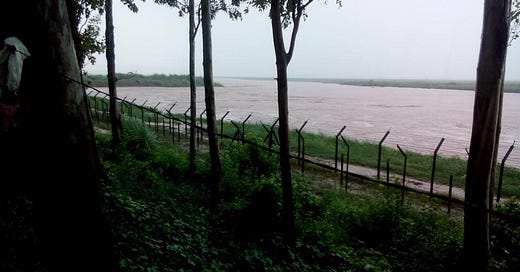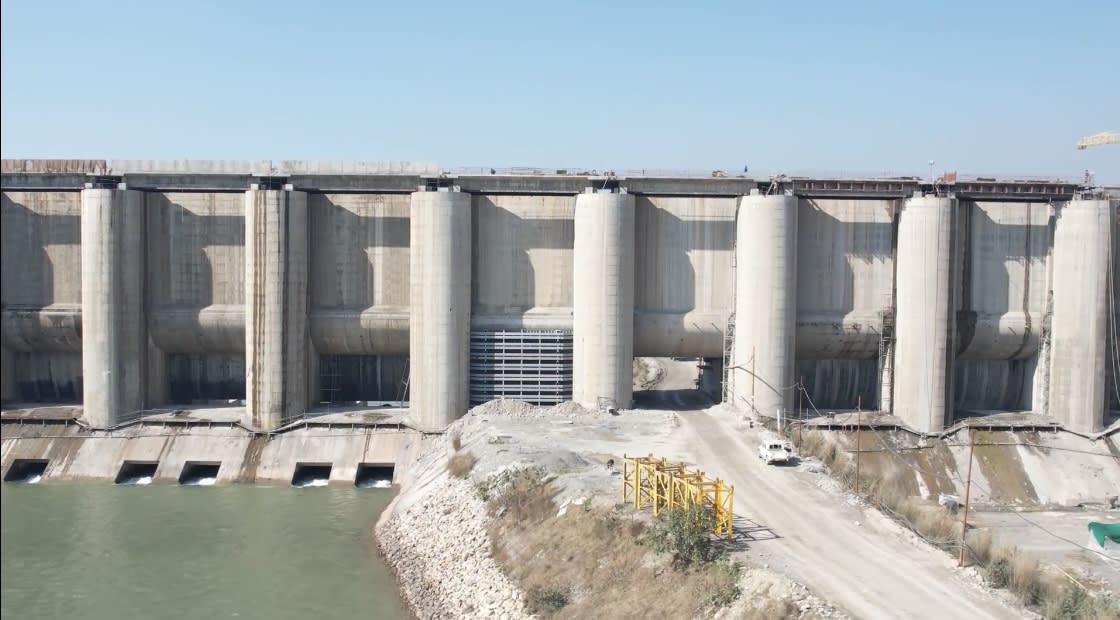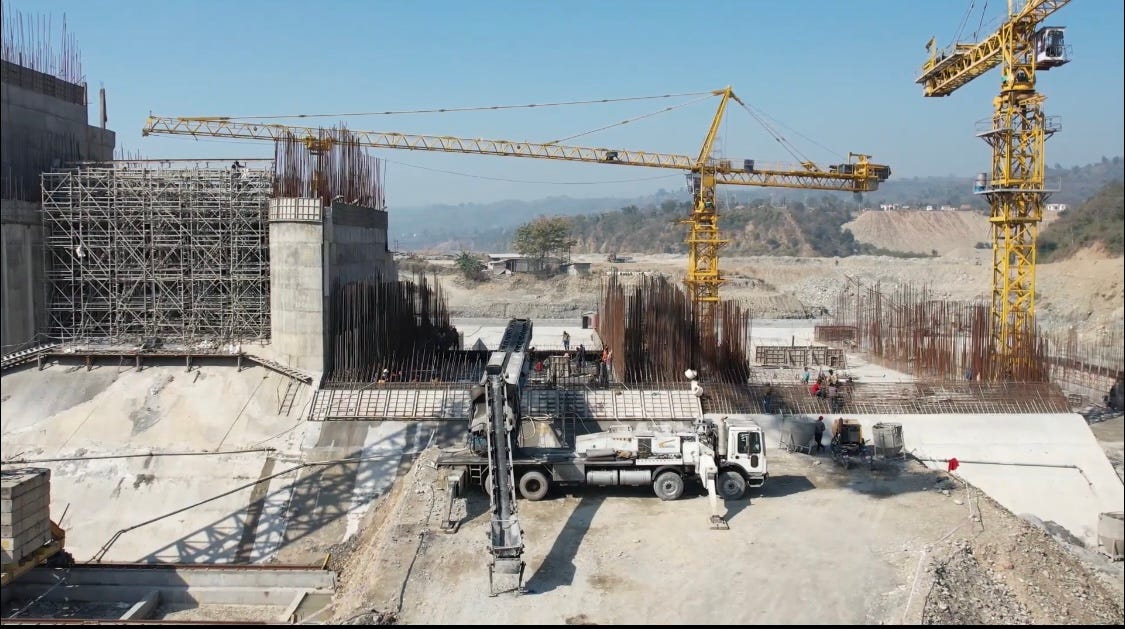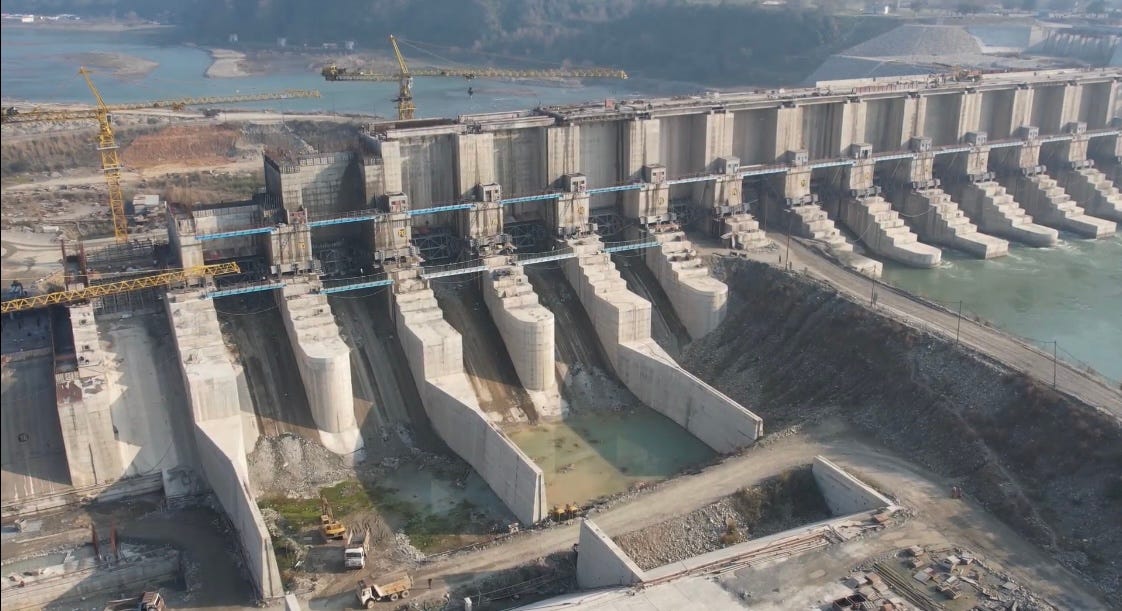Punjab's Water Wars: Securing Interest of the State in Ravi Waters
Analysis of the Proposed Ravi-Ujh Barrage at Makaura Pattan in Pathankot district: Upholding Punjab's Interests in Water Distribution.
Shahpur Kandi Dam Project on Ravi, downstream Ranjit Sagar Dam: 4th February, 2023 pics.
Introduction: Titled provocatively as "As Centre, Punjab, lock horns over of barrage of Ravi, Pakistan gets lakhs of cusecs of water," an article featured in the Chandigarh edition of “The Indian Express” on July 20, 2023. Penned by Kanchan Vasdev, the piece highlighted the ongoing stalemate between the Central Government and Punjab regarding the construction of a barrage on the Ravi-Ujh River. The absence of this barrage, valued at a mere Rs 433 crore, allows Pakistan to receive a significant amount of untapped water, amounting to lakhs of cusecs, it implied. The discharge in the Ujh rivulet, which reached 2.60 lakh cusecs on Wednesday, also poses a threat to the villages of Pathankot and Gurdaspur located along the Ravi River.
Indus Waters Treaty: It is important to note that, as per the Indus Waters Treaty of 1960, India has the right to utilize the Eastern Rivers, namely Sutlej, Ravi, and Beas, for its own purposes. However, for the Indus, Chenab, and Jhelum rivers, India can only use them for electricity generation and not for consumptive purposes such as irrigation. The Ujh rivulet is a seasonal stream that flows through the Kathua-Samba area of Jammu and Kashmir, meanders into Pakistan, and re-enters Indian territory in Pathankot district of Punjab before joining the Ravi River from its right bank at Makaura Pattan, just a couple of miles from the Indo-Pak Border.
Is Punjab’s stand unreasonable? At first glance, this article gives the impression that the delay in constructing this crucial project, to be funded 90% by the Central Government, is resulting in the outflow of precious water to Pakistan. However, it fails to consider a vital point: during the rainy season, when water levels are excessive, there is no demand for irrigation in either Punjab or Rajasthan. In such cases, the only viable option is to allow the water to flow to Pakistan; otherwise, it would cause flooding in the bordering districts of Amritsar, Gurdaspur, and Pathankot along the Ravi River, and Ferozepur and Fazilka along the Sutlej River.
Daurangla in Gurdaspur, now Pathankot district, August 2016: Ravi in spate.
Limitation of a Barrage: It should also be noted that a barrage, unlike a full-fledged dam, does not store a significant amount of water; it merely diverts the river's flow. Examples of existing barrages include Madhopur on the Ravi, Ropar on the Sutlej, and Harike at the confluence of the Sutlej and Beas rivers. Let us assume, for the sake of argument, that a barrage is constructed at Makaura Pattan on the Ravi River, just downstream of its confluence with the Ujh rivulet. During the monsoon season, this water would be of no use to either Punjab or Rajasthan and would still need to flow downstream to Pakistan.
Haryana’s advocacy for this project: Initially, this project was pushed by Haryana, suggesting that the construction of this barrage would help harness precious water during the lean season, estimated to be about 600 cusecs, which could augment the supply to the Upper Bari Doab Canal (UBDC) system, particularly the Kalanour and Ramdas distributaries, which are currently seasonal rather than perennial. However, the estimated 600 cusecs in the Ujh rivulet during the lean season seems to be an overestimate since even the Ravi River does not currently discharge more than 300-400 cusecs in the deficit months.
Makaura Pattan in Gurdaspur, now Pathankot district, August 2016: Ravi in spate.
Link-canal not beneficial for Punjab: Significantly, Haryana also proposed the creation of a new green-field link canal from the Makaura Pattan Barrage to Harike, which would carry the "surplus" water of the Ravi River and pour it into the Sutlej River. This water would then be carried to Rajasthan through the existing Rajasthan Feeder Canal and the Sirhind Feeder Canal. The corresponding saved water could be utilized from the existing Bhakra-Pong system under the Bhakra-Beas Management Board (BBMB) to provide additional water to Haryana.
Punjab’s concerns and objections: However, Punjab has valid objections to this arrangement. Firstly, Haryana is no longer a riparian state with respect to the Ravi River, so any new capacity created in this river is a matter solely between Punjab and Jammu and Kashmir. For example, Haryana has no right to share in the water or electricity generated by the now fully operational Ranjit Sagar Dam (RSD) (formerly Thein Dam) on the Ravi River, which is based on the Punjab and J&K bilateral agreement of 1978, following the reorganization of Punjab in 1966.
Secondly, the proposal overlooks the upcoming Shahpur Kandi Dam (SKD), downstream of the Ranjit Sagar Dam, which is a National Project scheduled for completion by 2024-25. The estimated completion dates are as follows: Main Dam - April 30, 2024; Power Houses Civil Works - October 31, 2024; Power Houses E&M Works - October 31, 2025. The SKD will further restrict the outflow of Ravi water into Pakistan. It should be noted that Haryana also has no share in the Shahpur Kandi Dam project either, despite its claims being lodged in the Supreme Court1.
Shahpur Kandi Dam Project on Ravi, downstream Ranjit Sagar Dam: 4th February, 2023 pics.
Thirdly, the construction of the Makaura Pattan Barrage would require the establishment of a new Ravi-Sutlej link canal up to Harike to carry Ravi waters during the lean season to the Sutlej River. During the rainy season, even Rajasthan is unable to absorb the excess water from the Sutlej River, resulting in most of it flowing wastefully to Pakistan downstream of Harike. Even if we assume that 600 cusecs of water would be available at the proposed barrage in the Ravi-Ujh combined stream, even after the Shahpur Kandi Dam Project is fully operational, the socio-economic costs, including land acquisition in Punjab, would not be justified by the potential benefits for Punjab.
Author in August 2012, along River Ravi
Last but not the least, if Punjab concedes to Haryana's nebulous claims regarding post-1966 projects related to Ravi River waters, it would be detrimental to Punjab's interests. Punjab would essentially be giving Haryana a foothold in the Ranjit Sagar Dam and Shahpur Kandi Dam projects, which are currently bilateral projects of Punjab and Jammu and Kashmir.
Lift- irrigation feasible? It should be noted that Punjab Water Resources Engineers have already examined the possibility of utilizing the proposed barrage through a lift-irrigation scheme to augment water supply in the UBDC system during the lean season. However, this scheme was deemed too costly when considering the augmented capacity of irrigation water. Therefore, the scheme as a standalone project for Punjab was not pursued.
Punjab should stick to its stand: Given the circumstances, Punjab should not be swayed by insinuations that its objections are frivolous and result in the provision of scarce and precious water to Pakistan at no cost. Punjab's priority should be the expeditious completion of the Shahpur Kandi Dam project on the Ravi River, which will primarily benefit Punjab, both in terms of irrigation and electricity, and to a lesser extent, Jammu and Kashmir.
Shahpur Kandi Dam Project on Ravi, downstream Ranjit Sagar Dam: 4th February, 2023 pics.
On a broader scale, since the overall availability of water in the Ravi-Beas system has drastically decreased, Punjab's demand for the establishment of a new Inter-State River Waters Tribunal should be immediately acknowledged and acceded to by the Government of India. This would enable a fair distribution of river waters among riparian states based on the possibly reduced availability due to factors such as shrinking glaciers. All states, including non-riparian Rajasthan, should face a proportionate cut if water availability decreases. The 1987 interim Award of the Eradi Tribunal is outdated and cannot provide an accurate contemporary picture of water availability. Who knows, the assessed quantity of water might be so low that it renders the ill-fated SYL canal unnecessary?
Punjab's policy and administrative decisions regarding river waters should be made by the Government only after consulting a diverse range of stakeholders within the state, including representatives from all political parties, farmer associations, irrigation and power technocrats, legal experts, and experienced current and retired bureaucrats. Newspaper reports should not trigger hasty policy, administrative, or legal decisions2.
Click to watch exclusive video regarding the progress of Shahpur Kandi Dam Project on river Ravi.
https://drive.google.com/file/d/1QimBhzD8WrV4jqSoC6ero1mJtKnXM4Zv/view?usp=drivesdk













"Punjab, its river waters and how SYL could become unnecessary"
"The Indian Express", today’s edition (i.e. July 27, 2913).
Carries my article on Punjab‘s river waters and SYL.
https://indianexpress.com/article/cities/chandigarh/punjab-ravi-river-barrage-8860517/
May like to peruse and share with our circulate to appropriate circles/ groups, if you deem fit.
Lt. Gen. (retd.) TS Shergill, the former Principal Advisor to the CM punjab, sent me the following comments. Posting with his approval.
"Dear KBS,
Thank you for an in-depth article on the use of Rivers Ujh-Ravi waters.
When the Brits designed the Canal systems river water was fed into canals much like distributaries of rivers. The canals were earthen that had the disadvantage that they could not flow as far south as would later, lined canals however, the overall hydraulic pressure on the earth by the spread of river waters was maintained and water continued to seep into the Indus Aquifer thus, maintaining sub-soil water levels that were still suitable for Persian wheel irrigation.
The advent of dams and lined canals together with electro-mechanical drawing of water from the aquifer has not only dropped sub-soil water levels alarmingly but also, pushed up arsenic laced water levels in South Punjab.
In addition, the Bhakra, Pong and Shahpur Kandi dams do not contribute to charging the Indus Aquifer unlike what was done in Arizona and New Mexico when the Colorado Dam (Hoover) was built- the Ogalalla Aquifer lies beneath from Dakota to Texas and from the Appalachian to Sierra Nevada mountains. They have devised a method of recharging the Aquifer with cleansed water, no doubt expensive.
We have long and broad river beds that have allowed a free-for-all 'mand' agriculture and grazing for cattle other than in the Monsoon. If the riverine system can be reclaimed as wetlands, charged each year by the Monsoons, it would help to resuscitate the Indus Aquifer and perhaps, alleviate the high levels of arsenic laden waters in South Punjab, enable a fishing industry and discontinue filling of pockets through illegal sand mining.
I regret that my pleas is this regard met a stone wall when I had a little influence in Government even when, the World Bank was planning to invest $100 million in agro-irrigation projects. To ask for expensive and direct recharging of the Aquifer would have been met with astonishment!
Warm regards,
Gen Shergill"